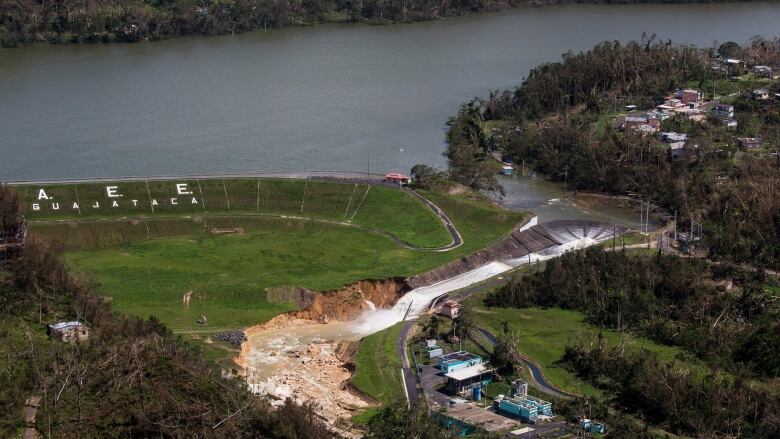Engineers inspecting Puerto Rico's cracked dam that could 'collapse at any minute'
'We don't know how long it's going to hold,' says governor, after damage caused by Hurricane Maria

Puerto Rico's government says engineers will inspect the Guajataca Dam on Sunday to determine the extent of damage inflicted by Hurricane Maria last week.
The dam in the northwest corner of the island was cracked, but had not burst by late Saturday. But Public Affairs Secretary Ramon Rosario said in a statement that the dam's "fissure was big and it will collapse at any minute."
Gov. Ricardo Rossello said, "We don't know how long it's going to hold. The integrity of the structure has been compromised in a significant way."
Fears that the dam would fail prompted the government to evacuate nearby communities below the reservoir with buses to help residents leave.
The 316-metredam was built around 1928. It holds back a man-made lake covering about fivesquare kilometres.
Nearly 40 centimetresof rain from Maria fell on the surrounding mountains.
- Powerless Puerto Rico's storm crisis deepens with dam threatening to fail
- A stunned Puerto Rico seeks to rebuild after Hurricane Maria
The U.S. National Hurricane Center says Hurricane Maria has weakened slightly as it moves northward, but it's still likely to bring increasing swells and high surf to the southeastern U.S. coast.
Maria, which walloped Puerto Rico as a Category 4 hurricane on Wednesday, is now a Category 2 storm with maximum sustained winds of 165 km/h.
The Hurricane Center says it was centred about 765 kilometressouth-southeast of Cape Hatteras, North Carolina before noon Sunday.

Aid begins flowing
Large amounts of federal aid have began moving into Puerto Ricoto stem a growing humanitarian crisis in towns left without fresh water, fuel, electricity or phone service.
Officials with the U.S. Federal Emergency Management Agency, which is in charge of the relief effort, said they would take satellite phones to all of Puerto Rico's towns and cities, more than half of which were cut off following Maria's devastating crossing of Puerto Rico on Wednesday.
The island's infrastructure was in sorry shape long before Maria struck. A $73-billion US debt crisis has left agencies like the state power company broke. As a result the power company abandoned most basic maintenance in recent years, leaving the island subject to regular blackouts.
A federal control board overseeing Puerto Rico's finances authorized up to $1 billion in local funds to be used for hurricane response, but Rossello said he would ask for more.
Officials said 1,360 of Puerto Rico's 1,600 cellphone towers were downed, and 85 per cent of above-ground and underground phone and internet cables were knocked out. With roads blocked and phones dead, officials said, the situation may worsen.
The death toll from Maria in Puerto Rico was at least 10, including two police officers who drowned in floodwaters in the western town of Aguada. That number was expected to climb as officials from remote towns continued to check in with officials in San Juan.
Across Puerto Rico, more than 15,000 people are in shelters, including some 2,000 rescued from the north coastal town of Toa Baja. Many Puerto Ricans planned to head to the mainland to temporarily escape the devastation.












_(720p).jpg)


 OFFICIAL HD MUSIC VIDEO.jpg)
.jpg)



























































































